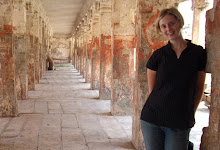After over a year with Unitus, I finally had the opportunity to see some microfinance in action last month and I thought I'd take the chance to give a quick explanation and post some pictures of my visit to a center meeting. Broadly, microfinance is financial services offered to the poor. These can include credit, savings, insurance, remittances, and other products. What people usually think of when they hear "microfinance" (and what Muhammad Yunus is famous for) is essentially a small, short-term business loan offered to a very poor woman. The typical microfinance client is too poor to secure a loan with collateral so she joins a group of five or so women, all of whom receive loans from the same MFI (microfinance institution) at the same time. While money is received and repaid individually, no woman in the group can receive a second loan until she AND her group members have paid back their loans. This innovative lending methodology has resulted in repayment rates that are much higher than those found at traditional banks. The women use their loan capital to purchase the supplies or equipment or workspace they need to engage in some type of business. One might purchase chickens with the upfront money, and then sell the eggs to generate ongoing revenue and pay back her loan. Another might invest in cooking equipment so that she can sell food on the street. The possibilities are endless. In my opinion, microfinance is revolutionary because it challenges the idea that the poor can't be trusted with money, or need to be
retrained. Poor people have many revenue-generating skills and money management skills - they simply lack collateral and access to capital. Many MFIs lend exclusively to women because repayment rates tend to be higher, and the social impact tends to be greater. A greater percentage of a woman's profits will go towards things - such as education - that benefit her family far into the future.
This center meeting was held about 45 minutes away from the city center, in one of Bangalore's large stretches of slums. These women were sitting on the floor of a member's home with many of their children crowded around the doorway.

Every woman had a yellow book (like the one that the woman in the blue sari is holding) in which they record their loan repayments and contributions to their savings accounts. They proudly showed the books to me and I observed that the average savings deposit was 50 rupees (or a little over one US dollar).


The weekly or bi-weekly center meeting is a chance for women to make loan payments, connect with the other members of their group, and ask any questions or talk about problems they were having. In general, they were chatty and seemed happy to be there. I kept getting distracted by their beautiful children, however.


Here are some scenes from their neighborhood. Some women who receive microloans become incense rollers.

The slums are filthy, filthy, filthy, and CROWDED, but not entirely depressing places to be. There were bright colors and beautiful, friendly children everywhere.







 The weekly or bi-weekly center meeting is a chance for women to make loan payments, connect with the other members of their group, and ask any questions or talk about problems they were having. In general, they were chatty and seemed happy to be there. I kept getting distracted by their beautiful children, however.
The weekly or bi-weekly center meeting is a chance for women to make loan payments, connect with the other members of their group, and ask any questions or talk about problems they were having. In general, they were chatty and seemed happy to be there. I kept getting distracted by their beautiful children, however.
 Here are some scenes from their neighborhood. Some women who receive microloans become incense rollers.
Here are some scenes from their neighborhood. Some women who receive microloans become incense rollers. The slums are filthy, filthy, filthy, and CROWDED, but not entirely depressing places to be. There were bright colors and beautiful, friendly children everywhere.
The slums are filthy, filthy, filthy, and CROWDED, but not entirely depressing places to be. There were bright colors and beautiful, friendly children everywhere.









